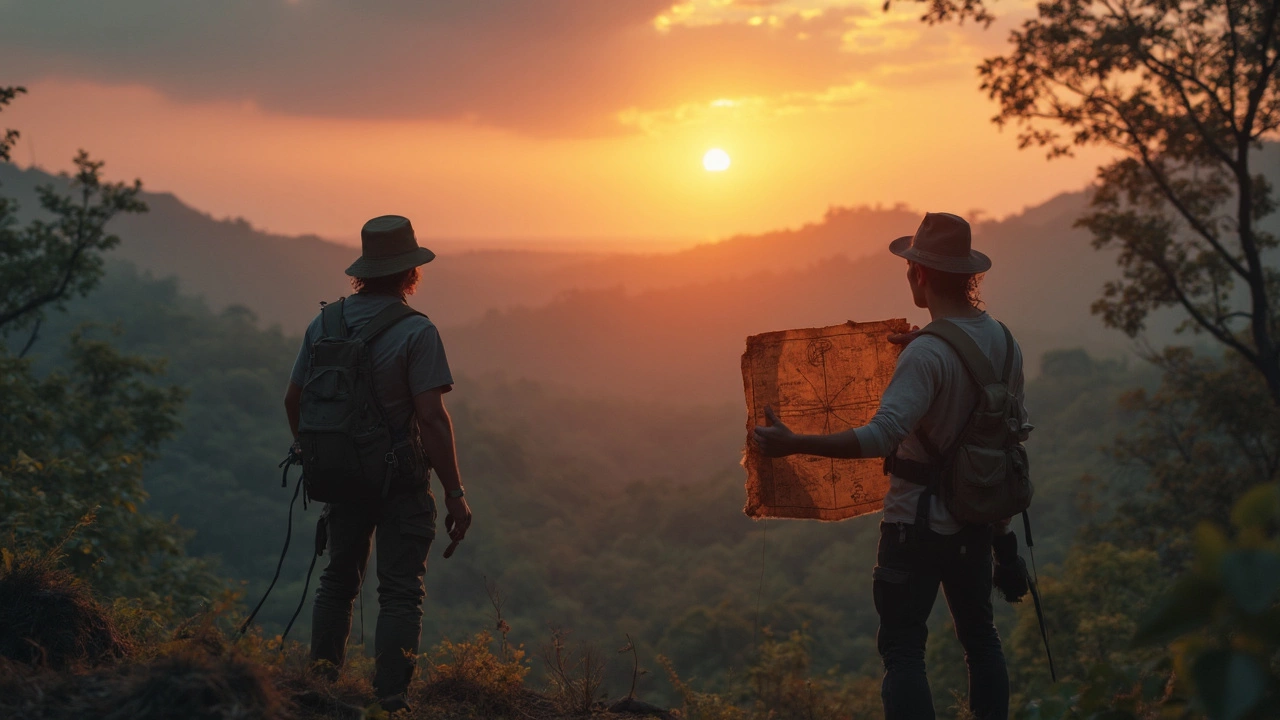Crafting the Perfect Adventure Story Plot
 Mar, 9 2025
Mar, 9 2025
Ever thought about writing an adventure story? It's all about stirring emotions and sparking excitement. The first thing you need is a killer hook. Seriously, right from the start, you want something that grabs attention, like a mysterious artifact discovered in an ancient ruin or a cryptic message leading to a hidden treasure.
Next, let's talk about the setting. Think of it like your story's playground. It could be anything from a dense jungle teeming with secrets to a futuristic city buzzing with high-tech wonders. Giving your reader a world that's rich and textured makes the adventure believable and immersive.
No good plot goes far without a hero. Characters are what pull readers into the adventure. Your protagonist should face genuine challenges that force them to make tough decisions, showing growth and vulnerability along the way. This could be a seasoned explorer on their last mission or a young kid thrust into uncharted territories.
- The Hook: Starting Strong
- World-Building: Setting the Stage
- Hero's Journey: Crafting an Engaging Protagonist
- Pacing and Conflict: Keeping the Momentum
- Twist and Resolution: Ending with Impact
The Hook: Starting Strong
In the world of adventure stories, the hook is your golden ticket to keeping readers glued from the start. Imagine your story like a movie. Those first few seconds are crucial. You need to tease just enough of the adventure to make them want more but without giving away the whole plot. Think of it like getting someone to watch a cliffhanger teaser—short, punchy, and full of promise.
A great example is J.K. Rowling's 'Harry Potter and the Philosopher's Stone', where we're sucked into Harry's world immediately with mysterious letters and a birthday surprise. How cool is that? It gives you a reason to question and a reason to follow Harry down his rabbit hole.
Create Instant Curiosity
You want to bait your readers with something intriguing. Maybe it's an unexpected event, an unusual character, or a mind-boggling question. Put your main character in a situation that screams for explanation. This could be as simple as a strange encounter or a puzzling scene that raises eyebrows. Why are there giant footprints in a town square?
Introduce a Problem or Conflict
Nothing sparks interest like a challenge or conflict. Start with an issue that your hero needs to address. Show your readers what's at stake early on—whether it's saving a city from a looming threat or finding a missing artifact before the bad guys do. This gives them a vested interest in the resolution.
Establish Mood and Tone
Get the tone right from the get-go. This isn’t just about setting the stage; it’s about creating a vibe that matches your adventure. Is it going to be dark and mysterious like a journey through a haunted jungle or light-hearted and full of surprises like a treasure hunt led by mischievous kids? Either way, your first few pages should paint this picture.
Start your storytelling adventure strong, and you’ll find your readers much more likely to come along for the ride, eager to turn the pages of your adventure story.
World-Building: Setting the Stage
Creating an incredible setting is like offering your readers a backstage pass into a whole new universe. A strong setting enhances your adventure story by giving it depth and dimension. Whether it's a bustling cityscape or a quiet village, your world should feel alive and cohesive.
Make It Believable
Even if your setting is fantastical, it needs some anchoring truths. Grounding your world in familiar elements—like traditional customs or natural laws—can make it relatable. For instance, if your plot unfolds in an alien desert, think about how the heat would affect the characters and their actions. This attention to detail adds credibility to your storytelling.
Incorporate the Five Senses
When building your world, don't just focus on what it looks like. Engage all the senses. Describe the aroma wafting from a bustling marketplace or the echoing sounds of laughter in a crowded tavern. Readers should feel like they’re walking through your setting; the sensory details help accomplish this.
Dynamic Environments
Got a gripping story unfolding in a dense jungle? Remember, environments aren't static. They change and influence the adventure. Maybe a thunderstorm turns clear skies into chaos, or shifting political tides alter safe havens into territories fraught with danger. Such changes not only enhance the plot but add layers to your setting.
Culture and Lore
Integrating local cultures and lore can make your world incredibly engrossing. Whether it's age-old traditions or mythical legends, these elements make the setting unique. A cautionary tale told by an elder could plant seeds for a subplot, while folklore might hint at hidden mysteries about to be uncovered by your protagonist.
So, when it comes to world-building, dive deep, immerse readers, and let your imagination run wild, but always loop back to what feels real and engaging.

Hero's Journey: Crafting an Engaging Protagonist
Creating a standout protagonist in an adventure story is like setting the stage for a memorable journey. This isn't just about giving your hero a flashy sword or extraordinary powers—it's about depth, relatability, and growth. Let's dive into how you can make your protagonist truly captivating.
Start with a Solid Background
Your character's past can shape their motivations and decisions. Are they a retired soldier seeking redemption, or maybe a science whiz kid testing their inventions in the wild? This background isn't just filler; it sparks their drive and helps readers connect.
Define the Goal
A good hero needs a clear objective. Whether it's retrieving a lost artifact or rescuing a friend, this goal should be enticing and substantial. The stakes need to be high enough to keep both the protagonist and readers on their toes.
Challenges and Growth
Adventure stories thrive on conflict and challenges. Make sure your hero encounters obstacles that test their skills and resolve. This is where character development shines. Maybe they face a moral dilemma, or their skills are put to the test in unexpected ways. How they handle these challenges reveals their true character.
Flaws Are Key
Perfection is boring. Give your protagonist a flaw or two. Perhaps they're stubborn, overly cautious, or have trouble trusting others. Watching them struggle and overcome these flaws can be one of the most rewarding parts of their journey.
Endearing Traits
Balancing flaws are the traits that make your protagonist likable. This could be their loyalty to friends, a sense of humor, or an unwavering belief in doing what's right. These traits humanize your hero and make readers root for them.
The Hero's Arc
The hero's journey isn't just about the adventure; it's a transformation. By the end of the story, your protagonist should emerge changed, having learned or grown in some way. This could be a newfound courage, a deeper understanding of themselves, or a restored sense of purpose.
Putting time and thought into crafting your hero ensures they'll resonate with readers. A well-developed protagonist is crucial in making your adventure story unforgettable.
Pacing and Conflict: Keeping the Momentum
So, you've got a strong start and an intriguing world for your adventure story. What keeps your readers flipping the pages? It's pacing and conflict. There's a delicate balance between giving readers time to breathe and hitting them with enough thrills to keep them engaged.
When we talk about pacing, think of it as the rhythm of your story. Slow moments are like calm before the storm where you delve into character development or explore the storytelling aspects deeper. They're crucial, but so are the bursts of excitement—the breathtaking chases, heart-pounding escapes, and intense confrontations.
Maintaining the Right Pacing
Never keep an adventure stuck in one tempo. You want to create a rollercoaster experience. A good rule of thumb is to alternate between action-packed scenes and slower, more introspective parts. This not only keeps things interesting but also builds anticipation.
- Start with high action to hook your audience.
- Use slower scenes to build suspense or explore character backgrounds.
- Continue with rising action, leading to a climactic midpoint.
- Include small peaks of action to maintain interest after the midpoint.
- End with a bang—a finale that ties together loose ends with high stakes.
Adding Conflict
Conflict is the engine that drives your story forward. Think of it as challenges your characters face, whether it's a battle with a villain, nature, or even themselves. Not all conflicts need to be epic battles. They could be internal struggles, moral dilemmas, or clashing ideals.
Creating believable conflict can make your characters' victories sweeter and their losses more affecting. It makes readers root for them, makes them care. Imagine a creative writing scene where your explorer finally discovers the hidden treasure, only to find it's guarded by the friend who’s betrayed them. That's conflict at its finest.
Done right, pacing and conflict can make your adventure story unforgettable. The equilibrium of fast-slow rhythms and meaningful conflicts ensures that your readers are not just entertained but also emotionally invested.

Twist and Resolution: Ending with Impact
Nailing a story's end is crucial. It's your moment to leave readers awestruck, and a good twist can do just that. A solid twist should feel surprising yet inevitable in retrospect. Think of the reveal in 'The Sixth Sense'—it was shocking, but all the clues were there if you went back and looked. That's the kind of impact you're aiming for.
Consider upping the stakes in your adventure story. Maybe the treasure your hero's been chasing was a decoy all along, or the real villain is someone they trusted. These twists add depth and keep readers glued to the page.
"A story's ending should deliver on its promise but with a punch, leaving the reader satisfied and perhaps even questioning what they thought they knew." - Stephen King
After the twist, the resolution ties up your plot but doesn't have to spell out every detail. It's about resolution as much as it is about leaving some space for your readers' imagination. One approach is to let your audience see how the adventure transformed your hero. Did they find internal peace? Or maybe they learned a valuable lesson that's more precious than any physical reward?
Remember, pacing here is key. You don't want a flashy twist without proper buildup or a hasty resolution that leaves threads dangling awkwardly. Balance action and emotion to keep it engaging till the last word. A well-crafted ending isn't just a conclusion—it's the final emotional resonance that lingers long after the book is closed.